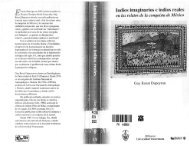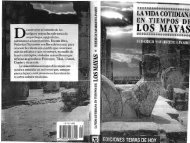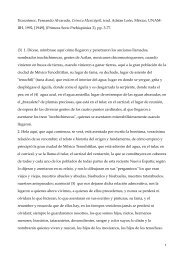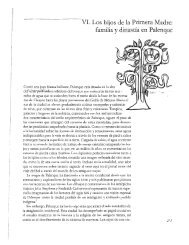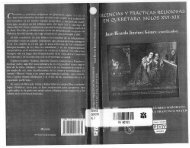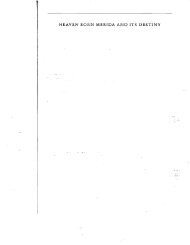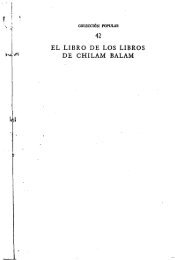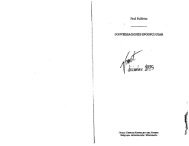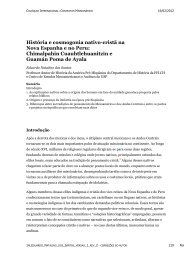- Page 1 and 2: THE ANCIENT FUTURE OF THE ITZA w* k
- Page 3 and 4: The Ancient Future of the Itza The
- Page 5 and 6: T u men ah miatzob Ba Cabob: Sir J.
- Page 7 and 8: Acknowledgments Introduction xi ix
- Page 9 and 10: GULF OF MEXICO 0 1 ITZA 0 o • CUP
- Page 11: Xll INTRODUCTION (or twenty tuns of
- Page 15 and 16: Xvi INTRODUCTION The Itza What foll
- Page 17 and 18: XV111 INTRODUCTION Pencil drawing o
- Page 19 and 20: XX INTRODUCTION Perhaps the most st
- Page 21 and 22: From the end of the Xiu cycle in 69
- Page 23 and 24: chief of the Toltec Xiu. It was 710
- Page 25 and 26: territory of Champoton. From 968 to
- Page 27 and 28: Ceel, Cinteotl the Younger, Tzontec
- Page 29 and 30: Spanish first saw Yucatan, eighty y
- Page 31 and 32: By 1461 it was the Xiu time to deco
- Page 33 and 34: the ceiba sacrifices to end the cyc
- Page 35 and 36: Can Ul, dividing the heirs of Hapay
- Page 37 and 38: EIGHT AHAU 21 (note continued from
- Page 39 and 40: Katun 6 Ahau was the tenth in the I
- Page 41 and 42: The prophecy of Ahau Pech from star
- Page 43 and 44: WiSftSiKT THE SIXTEENTH CENTURY
- Page 45 and 46: 3o 13 Ahau was the thirteenth in th
- Page 47 and 48: 32 and in 1527 he told the sun prie
- Page 49 and 50: 34 the sun priests Kauil Ch'el, Aha
- Page 51 and 52: 36 THE SIXTEENTH CENTURY of Emal wa
- Page 53 and 54: 38 die of Uo, Emal and Hoi Tun Zuyu
- Page 55 and 56: 40 arily, there are seven honey tam
- Page 57 and 58: 42 Merida was the seat of the katun
- Page 59 and 60: 44 fate of 11 Ahau, and poor food w
- Page 61 and 62: 46 THE SIXTEENTH CENTURY Itza Gods
- Page 63 and 64:
48 THE SIXTEENTH CENTURY Tzec; the
- Page 65 and 66:
50 which came to the center of the
- Page 67 and 68:
52 envy is his soul. Mad was the pr
- Page 69 and 70:
54 not mine, for it happened thrice
- Page 71 and 72:
56 Tzin Yabun the Younger's prophec
- Page 73 and 74:
sembled, but they were usurpers try
- Page 75 and 76:
6o THE SIXTEENTH CENTURY and the be
- Page 77 and 78:
62 THE SIXTEENTH CENTURY time, with
- Page 79 and 80:
64 Everything was torn up by war in
- Page 81 and 82:
5 Ahau was the fourth in the Itza k
- Page 83 and 84:
Ma Zuy and Ben Pal were allies and
- Page 85 and 86:
^s 1 invented in Mayapan, and was t
- Page 87 and 88:
IV -r I 1 W Ai I: î e£ I MULUC (1
- Page 89 and 90:
OÍ2 fe forced migrations in the se
- Page 91 and 92:
Then spoke the lesser priests. And
- Page 93 and 94:
M there was famine and then later d
- Page 95 and 96:
The city traitor, the pretended eas
- Page 97 and 98:
I m 8 KAN (1601) In 1601 in 5 Ahau
- Page 99 and 100:
•Ai the monuments for the ancesto
- Page 101 and 102:
m. f joicing of the rebels, as Ol Z
- Page 103 and 104:
,-tó ticipating by ten years what
- Page 105 and 106:
•fît FIVE AHAU 91 -$j converted
- Page 107 and 108:
his sash. Solemnly they made the ci
- Page 109 and 110:
i began, and the next day was the o
- Page 111 and 112:
L year of dissipation, adults and c
- Page 113 and 114:
ma the attacks and plague that affl
- Page 115 and 116:
icy and priesthood of the katun, sh
- Page 117 and 118:
accounts of Puc Tun, the Spokesman
- Page 119 and 120:
¥ the Maya lords, Cap Uah spread t
- Page 121 and 122:
Bech' came to the lake and caused c
- Page 123 and 124:
to divide the land, weakening it, e
- Page 125 and 126:
Tun and Xopan Náhuatl, sun priests
- Page 127 and 128:
3 Ahau was the fifth in the Itza ka
- Page 129 and 130:
ter to the wilderness, and 01 Zip a
- Page 131 and 132:
1 a* THREE AHAU 117 16. can Cib 17.
- Page 133 and 134:
m THREE AHAU II9 13. ox Ymix 14. ca
- Page 135 and 136:
I M THREE AHAU 121 29. buluc Lamat
- Page 137 and 138:
I; n % is. THREE AHAU 14. noil Ix 1
- Page 139 and 140:
t - .V Vi- 1 ç? i : • r. i THREE
- Page 141 and 142:
I THREE AHAU 127 16. lahca Etz'nab
- Page 143 and 144:
U Like the preceding chapter, this
- Page 145 and 146:
i» Si fe i 1. is. THREE AHAU 131 Y
- Page 147 and 148:
i THREE AHAU 133 T u lacal ocsah ob
- Page 149 and 150:
í I s & ! Zuyua was the seat of ka
- Page 151 and 152:
a even in Mayapan by sacrifices in
- Page 153 and 154:
country and the city, even Merida t
- Page 155 and 156:
the true prophecy to the world from
- Page 157 and 158:
I: was the end of the capital God w
- Page 159 and 160:
Valladolid was the seat of katun 12
- Page 161 and 162:
. katun ended in the selection of t
- Page 163 and 164:
. ter as the local books said. For
- Page 165 and 166:
10 Ahau was the eighth in the Itza
- Page 167 and 168:
'W monies of the four Fathers of th
- Page 169 and 170:
Katun 8 Ahau was seated at Mayapan,
- Page 171 and 172:
m Such was the evil power of Kak Mo
- Page 173 and 174:
1 1 ! t I state killing village hea
- Page 175 and 176:
i î I Y i Î I i r \ the water pri
- Page 177 and 178:
Teabo was the seat of katun 4 Ahau.
- Page 179 and 180:
every one of them. Such were the lo
- Page 181 and 182:
and the year and the katun come out
- Page 183 and 184:
starts over. At the time of the tun
- Page 185 and 186:
TWO AHAU 173 1764 cabil Cauac 1765
- Page 187 and 188:
TWO AHAU 175 Ma ix macma lub on i T
- Page 189 and 190:
This text begins with a table corre
- Page 191 and 192:
The final lines imply divination fr
- Page 193 and 194:
THIRTEEN AHAU 183 1758 hunil Kan ti
- Page 195 and 196:
This is the history of God by the p
- Page 197 and 198:
end of the faguar priesthood. Like
- Page 199 and 200:
tribute and the establishment of Ch
- Page 201 and 202:
against Havana, which was apostate.
- Page 203 and 204:
tories like those of Ahau Pech, and
- Page 205 and 206:
Appendix: The Mayan Calendar The Bo
- Page 207 and 208:
THE MAYAN CALENDAR 197 The Tikal Ca
- Page 209 and 210:
Yearbearer Type Days {Kin) I II III
- Page 211 and 212:
202 BIBLIOGRAPHY EDMONSON, MUNRO S.
- Page 213 and 214:
Entries in the index are primarily
- Page 215 and 216:
Cabil Neb A, 16 cabildo (Sp. 'town
- Page 217 and 218:
8 Ahau (1461) to 13 Ahau (1800), 34
- Page 219 and 220:
God, 119, 198, 412, 517, 541, 645,
- Page 221 and 222:
226; day and night, 1372,1734,1776,
- Page 223 and 224:
Morley, Sylvanus G., 442 mother, 18
- Page 225 and 226:
lamentation; mourning; pacing; pena
- Page 227 and 228:
Tozzer, Alfred M., 118, 144, 261, 3



